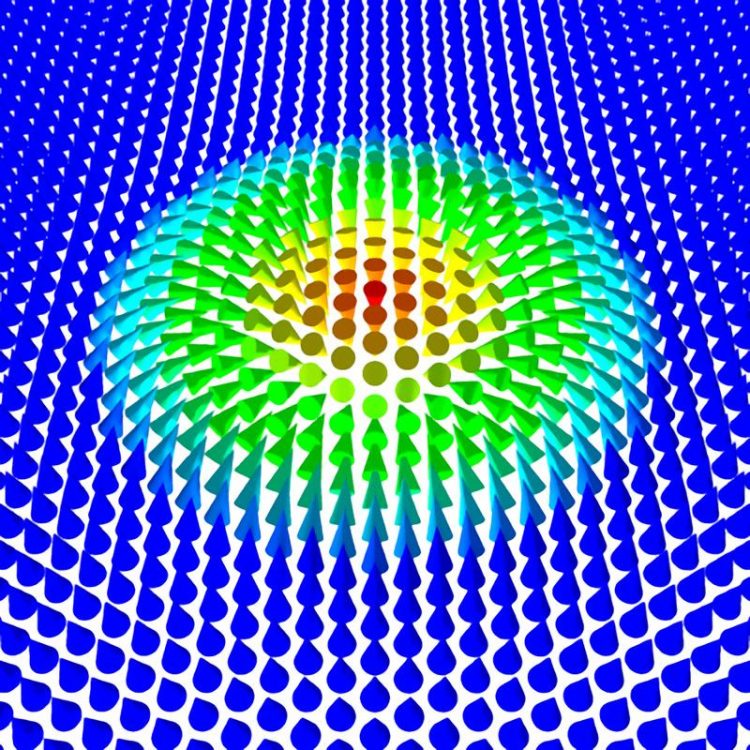Hamburg and Kiel researchers observe spontaneous occurrence of skyrmions in atomically thin cobalt films

Fig. 1: Illustration of a magnetic skyrmion with a diameter of only a few nanometres in an atomically thin cobalt film. The small colored cones represent the "atomic magnets" of each cobalt atom. S. Meyer, CAU Kiel
The existence of magnetic skyrmions as particle-like objects was predicted 30 years ago by theoretical physicists, but could only be proven experimentally in 2013. Skyrmions with a diameter from micrometers to a few nanometers were discovered in different magnetic material systems.
Although they can be generated on a surface of a few atoms and manipulated with electric currents, they show a high stability against external influences. This makes them potential candidates for future data storage or logic devices.
In order to be competitive for technological applications, however, skyrmions must not only be very small, but also stable without an applied magnetic field.
Researchers at the universities of Hamburg and Kiel have now taken an important step in this direction. On the basis of quantum mechanical numerical calculations carried out on the supercomputers of the North-German Supercomputing Alliance (HLRN), the physicists from Kiel were able to predict that individual skyrmions with a diameter of only a few nanometres would appear in an atomically thin, ferromagnetic cobalt film (see Fig. 1).
“The stability of the magnetic knots in these films is due to an unusual competition between different magnetic interactions,” says Sebastian Meyer, PhD student in Prof. Stefan Heinze's research group at the Kiel University.
This prediction was subsequently confirmed by Hamburg researchers around Dr. Kirsten von Bergmann using high-resolution scanning tunneling microscopy. The low-temperature measurements by Marco Perini, PhD student in the research group of Prof. Dr. Roland Wiesendanger, show magnetic skyrmions in the prepared cobalt films without an external magnetic field having to be applied (see Fig. 2).
“So far, individual skyrmions have almost always been generated by magnetic fields. In our metal films the skyrmions occur spontaneously,” explains Kirsten von Bergmann. “For future applications in spinelectronics the skyrmions must not only be stable at extremely low temperatures, as in the metal films investigated, but also at ambient temperature. In order to realize this next step towards application, the competition between different magnetic interactions found here can make a major contribution.”
Dr. Kirsten von Bergmann
Fachbereich Physik
Universität Hamburg
Telefon: 040 / 42838-6295
E-Mail: kbergman@physnet.uni-hamburg.de
Web: https://hp.physnet.uni-hamburg.de/kbergman/
Prof. Dr. Stefan Heinze
Institut für Theoretische Physik und Astrophysik
Christian-Albrechts-Universität zu Kiel
Telefon: 0431 / 880-4127
E-Mail: heinze@theo-physik.uni-kiel.de
Web: www.itap.uni-kiel.de/theo-physik/heinze
Isolated zero field sub-10 nm skyrmions in ultrathin Co films,
Sebastian Meyer, Marco Perini, Stephan von Malottki, André Kubetzka, Roland Wiesendanger, Kirsten von Bergmann und Stefan Heinze, Nature Communications.
DOI: https://doi.org/10.1038/s41467-019-11831-4
Media Contact
All latest news from the category: Physics and Astronomy
This area deals with the fundamental laws and building blocks of nature and how they interact, the properties and the behavior of matter, and research into space and time and their structures.
innovations-report provides in-depth reports and articles on subjects such as astrophysics, laser technologies, nuclear, quantum, particle and solid-state physics, nanotechnologies, planetary research and findings (Mars, Venus) and developments related to the Hubble Telescope.
Newest articles

A ‘language’ for ML models to predict nanopore properties
A large number of 2D materials like graphene can have nanopores – small holes formed by missing atoms through which foreign substances can pass. The properties of these nanopores dictate many…

Clinically validated, wearable ultrasound patch
… for continuous blood pressure monitoring. A team of researchers at the University of California San Diego has developed a new and improved wearable ultrasound patch for continuous and noninvasive…

A new puzzle piece for string theory research
Dr. Ksenia Fedosova from the Cluster of Excellence Mathematics Münster, along with an international research team, has proven a conjecture in string theory that physicists had proposed regarding certain equations….



